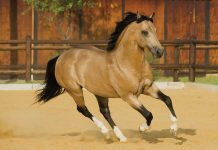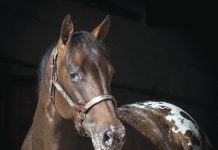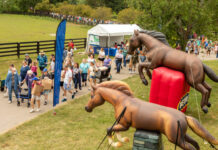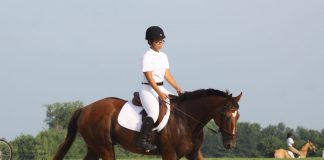You know how much fun it is to gallop and jump your favorite horse, but did you know that your success in the show arena or out on the cross-country course depends on the flatwork you do at home. It may be boring to go round in circles in the arena, but regular schooling sessions on the flat will help to make your horse more obedient—and this comes in handy when you’re heading towards an three-foot oxer!
Set aside 25 minutes for each schooling session. But now what should you do? It’s easy when you take a lesson because your trainer tells you what to do. But it can be difficult to come up with things to do when you’re riding by yourself. No problem. We’ve come up with some simple arena figures that you can do at the walk, trot and canter. Doing these figures will increase your horse’s fitness and help her to become more supple. Changing direction frequently will work her muscles equally on both sides, and doing lots of transitions will improve her balance. It’s all good!
Crossing the Diagonal
Going across the diagonal at the trot is an easy way to change your direction, and you should change your direction a lot when you’re schooling on the flat.
Prepare your horse for the turn before you actually get to the corner of the arena. Do a half halt and collect her a bit as you ride on the straight line before the corner.
Press with your inside leg at the girth to ask her to bend her body. Squeeze on the inside rein, but keep a firm hold on the outside rein. Press your outside leg behind the girth so she doesn’t fall to the outside.
Ride your horse deep into the corner of the arena and then turn her away from the track and aim across the arena on the diagonal line. As you turn onto the diagonal, sit up tall, look straight ahead and focus on where you’re going.
As you ride across the arena, remember to change your diagonal. Aim to hit the track about three feet before the marker (K, H, M, F) you’re heading towards so you’ll have time to balance your horse before the next corner. The corner will come up quickly!
Spirals
Riding spirals is a super way to teach your horse to move away from your leg. You can do spirals at a walk, trot or canter. Start out in a 20-meter circle at the walk. Squeeze the inside rein to ask your horse to turn her head in slightly, but keep a hold of the outside rein so she doesn’t fall inwards. Move your inside leg to the girth and your outside leg behind the girth.
Squeeze with alternate legs to keep your horse moving forward briskly. Begin spiraling in (making the circle smaller by gradually moving towards the center.) Sit tall, maintain a firm outside rein and use your outside leg on your horse to push her in a few feet. Continue spiraling in as you walk around the circle until you’re on a 15-meter circle. Then use your inside leg to push her out again bit by bit until she’s on the 20-meter circle again. Repeat this exercise at the trot and then at the canter. Try to maintain the same rhythm at the trot and canter. Don’t slow down and speed up on the circle.
Serpentines
Serpentines are simply half circles that you ride from one end of the arena to the other. They are a great way to practice bending and straightening with your horse. You can do two or three loops easily in a small dressage arena (20 meters by 40 meters.) Try a serpentine at the walk first. Ask your horse to bend around your inside leg as you make the loop of the serpentine near the rail. Then ask her to straighten out for the walk across the arena. Make sure that both of your hands are even and that both reins are the same length.
At the trot, think about asking for a half halt each time you cross the center line. This will help your horse be more balanced before you ask her to bend around the loopy part of the serpentine.
The Quarter Line
Do you know what the quarter line is? It is a straight path that sits between the arena’s center line and the arena’s rail. It’s about 10 feet from the rail. Riding on the quarter line is a great way to work on getting your horse to be straight as he moves forward. Start your turn on the quarter line when you pass A or C.
Begin by asking your horse to bend her head slightly inwards, and press out with your inside leg to ask her to bend her body. Keep your outside leg behind the girth and hold your outside rein firmly so she doesn’t fall to the outside. As she heads out on the quarter line, make sure both your reins are even and that you are sitting in the middle of the saddle.
Sit up straight to help your horse stay balanced on the path ahead. Remember, you don’t have the wall to help keep your horse straight, your legs and body must do it for you!
Leg Yielding
Leg yielding is simply asking your horse to move forward and sideways at the same time for several steps. You can ask your horse to leg yield from the rail to the quarter line (now that you know where it is), or you can ask her to leg yield from the quarter line to the rail.
Start by walking down the quarter line for a few strides. Maintain even rein contact so your horse’s body stays straight. If you’re leg yielding right, squeeze lightly on the left rein so your horse bends very slightly to the left. Keep your right leg slightly behind the girth to help keep her middle area straight and then use your left leg at the girth to push him over to the right. If she doesn’t move sideways, push a little harder or bump her with your left leg to encourage her to move over.
After three or four strides, bring both hands back to her neck, move both legs to the girth area and ask her to walk straight forward again.





